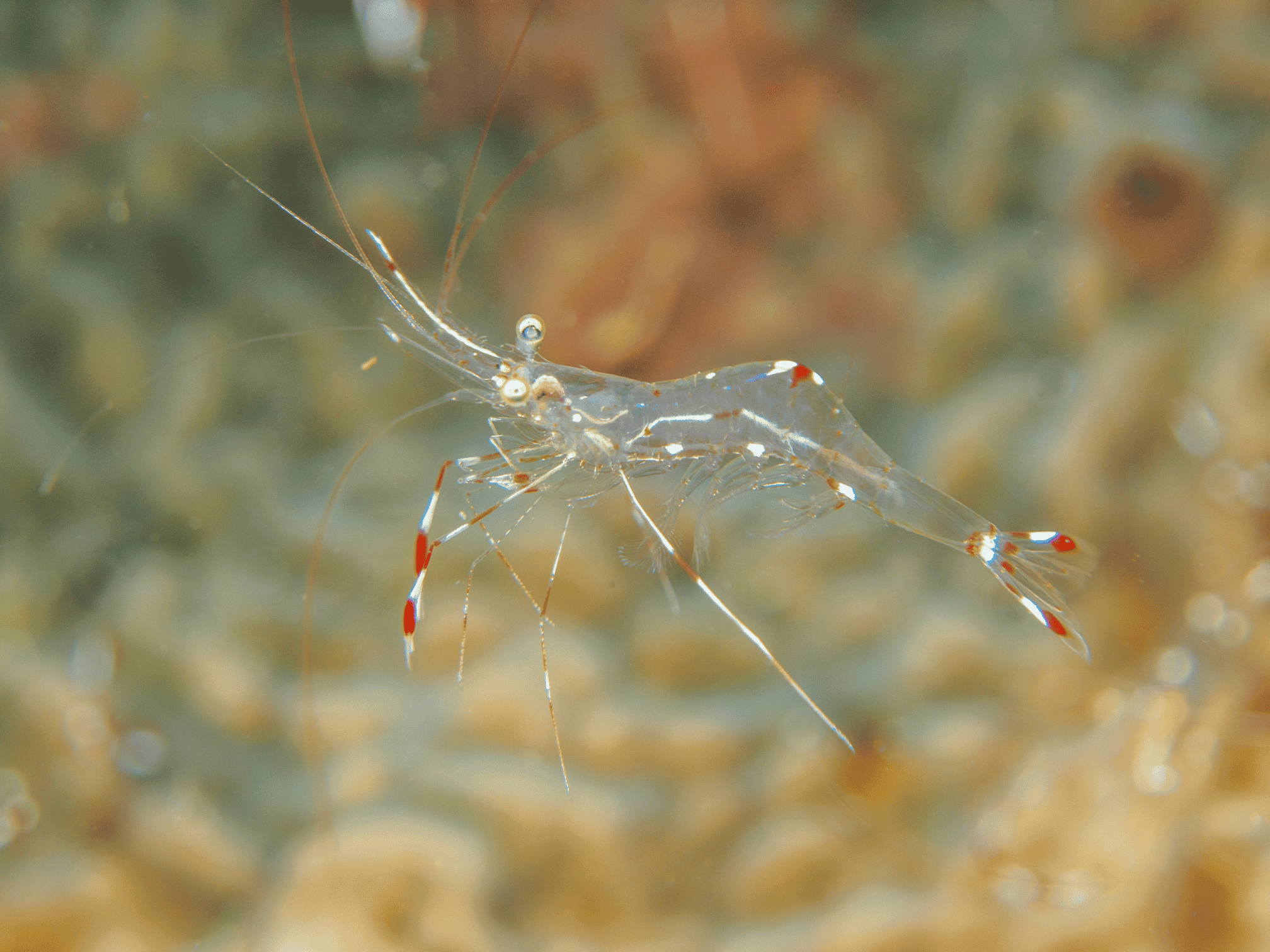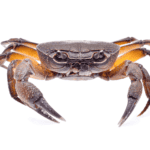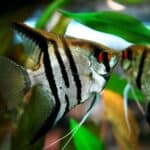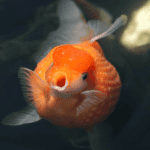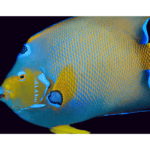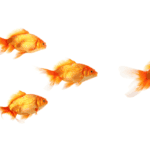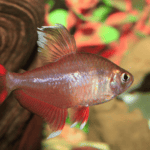Ghost shrimp, with their unique transparent bodies, have become increasingly popular in the aquarium hobby for their intriguing appearance and utility. These small invertebrates, not only serve as a window into the inner workings of aquatic life due to their see-through skin, but also double as efficient tank cleaners. Their ability to consume algae and leftover food helps maintain a clean and healthy environment within the tank.
We often incorporate ghost shrimp into freshwater aquariums not just for their cleaning benefits, but also as a source of entertainment. Watching these shrimp scuttle across the substrate or interact with other tank inhabitants can be a delightful experience. Setting up a proper habitat for them involves considering the specific parameters they require, such as water temperature, pH, and tank mates, to ensure a harmonious living space that promotes their wellbeing.
Key Takeaways
- Ghost shrimp are valued for their transparent appearance and tank cleaning abilities.
- They contribute to tank health by feeding on algae and detritus.
- Proper tank setup and maintenance are crucial for their survival and happiness.
Ghost Shrimp Basics

When we consider Ghost Shrimp, it’s crucial to understand their classification, distinctive appearance, and typical behaviors. This comprehension forms a foundational knowledge that is essential for anyone interested in keeping these intriguing creatures.
Taxonomy and Origin
Ghost Shrimp, also known as Glass Shrimp, are primarily classified as Palaemonetes paludosus. Originating from North America, they are well-adapted to the freshwater ecosystems they inhabit. As an easy-to-care-for species, Ghost Shrimp are popular in the aquarium trade, where they are appreciated for their beneficial characteristics.
Physical Description
The typical size of an adult Ghost Shrimp is about 1.5 inches, with a transparent exoskeleton that often makes them nearly invisible against the backdrop of their environment. Their bodies are equipped with long antennae, aiding in their sensory perception. The transparency of their bodies serves as a defense mechanism, helping them to evade predators.
Typical Behavior
Ghost Shrimp are known for their peaceful behavior, making them ideal companions in a community aquarium. They spend most of their time scavenging for food or digging through substrate. Providing them with adequate hiding places is essential, as these shelters mimic their natural environments and help them feel secure. Their activity often provides a fascinating spectacle while also contributing to the cleanliness of the tank by eating algae and detritus.
Aquarium Considerations
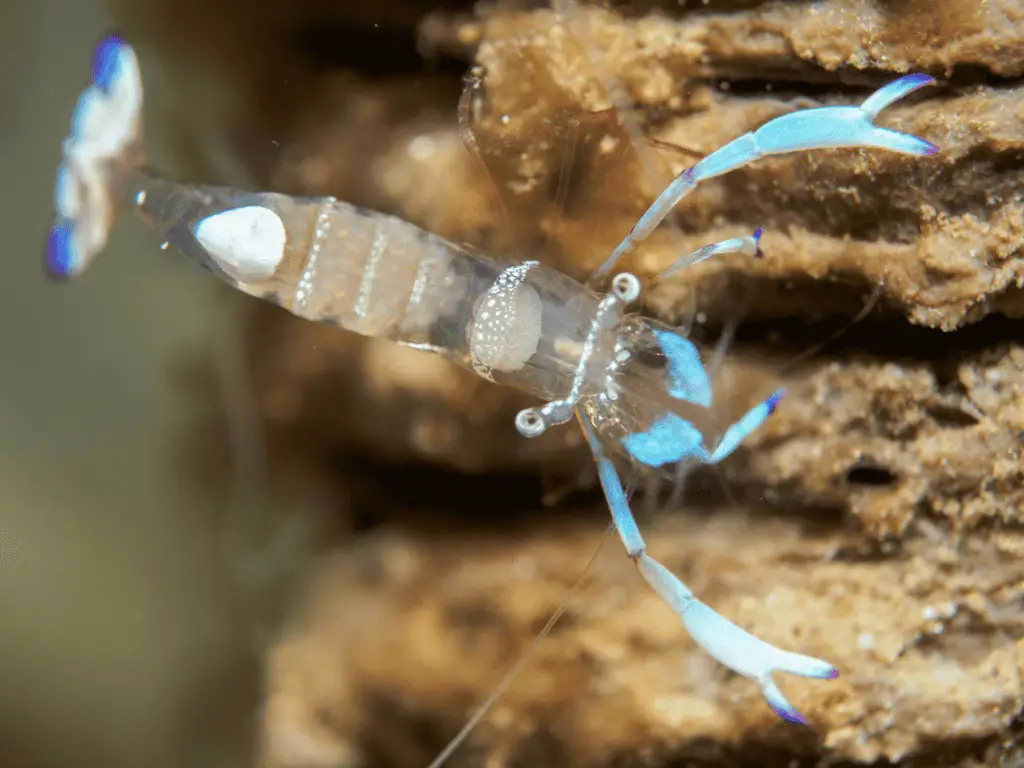
When setting up an aquarium for ghost shrimp, we must focus on tank size, water quality, and regular maintenance to ensure a healthy living environment.
Proper Tank Setup
Minimum Tank Size: For ghost shrimp, a 5-gallon tank is often sufficient, though a 10-gallon tank offers more stability and room for the shrimp to roam. Substrate should consist of fine sand or small gravel to allow for easy burrowing. Live plants like Java Fern or Anubias offer hiding places and contribute to the tank’s ecological balance, while driftwood and rocks can be added to create a more natural and enriching environment.
Lighting should be moderate to support plant life without encouraging excessive algae growth. The tank should be cycled before introducing shrimp to ensure a stable environment.
Water Quality and Parameters
Ensuring proper water quality is crucial for the health of ghost shrimp. We must maintain the water parameters within the optimal ranges:
- Temperature: 70-80°F (21-27°C)
- pH: 6.5 – 8.0
- General Hardness (GH): 5-8 dGH
- Carbonate Hardness (KH): 3-15 dGH
Regular monitoring of ammonia, nitrite, and nitrates is essential, as their levels should always be:
- Ammonia: 0 ppm
- Nitrite: 0 ppm
- Nitrates: <20 ppm
Water hardness plays a role in molting, so maintaining it within the proper range supports shrimp health.
Filtration and Maintenance
Filtration should be gentle to prevent ghost shrimp from getting sucked into the apparatus; a sponge filter is often preferred due to its safety for small tank inhabitants.
Regular tank cleaning includes vacuuming the substrate to remove waste and uneaten food and changing 10-25% of the water weekly, depending on tank size and population. It’s important not to over-clean, though, as shrimp rely on beneficial bacteria and biofilm as a food source. Keeping water quality high reduces stress and the likelihood of disease outbreak among shrimp.
Diet and Feeding
Before we examine the feeding habits, it’s crucial to understand that Ghost Shrimp are omnivorous scavengers. They play a vital role in their ecosystem by consuming a variety of organic materials.
Feeding Habits
We can observe that Ghost Shrimp are not particularly picky eaters. Their diet typically consists of algae, microorganisms, and detritus—which is dead plant and animal matter.
- Algae: These shrimp often graze on algae growing on tank surfaces and plants.
- Plants: They feed on decaying plant matter, but will generally leave healthy plants alone.
- Detritus: A main component of their diet, consisting of dead organic material, such as fragments of fish food and decaying vegetation.
Ghost Shrimp also willingly accept various types of shrimp food available on the market, including:
- Sinking pellets or flakes
- Algae wafers
- Spirulina tablets
- Blanched vegetables (e.g., zucchini, spinach)
In a typical aquarium setting, they are excellent at keeping the substrate clean by continuously scavenging for food. Moreover, their feeding actions help in the breakdown of waste, contributing to the overall health of their environment.
We prepare the tank environment to meet their dietary needs by ensuring a balance of algae and available detritus, together with supplementing their nutrition with high-quality shrimp food. This not only sustains the Ghost Shrimp but also encourages their natural foraging behavior.
Health and Wellness
In the realm of keeping ghost shrimp, it’s crucial we monitor their health and address the challenges they face throughout their life cycle, mainly diseases and issues with molting.
Common Health Issues
We must be vigilant against a range of health issues that can afflict ghost shrimp, making them vulnerable. Bacterial infections are common and can lead to disease if left unchecked. These infections often manifest as milky or discolored patches on the shrimp’s body. Parasites, such as Vorticella, are another concern; these typically present as tiny, white, cotton-like growths. Stress, which may stem from poor water quality or inadequate tank mates, can weaken their immune system, making them more susceptible to illness. To prevent these health issues, we should:
- Maintain clean water conditions
- Carry out regular water changes
- Ensure a balanced diet
Molting and Growth
Molting is a critical process in a ghost shrimp’s life, during which it sheds its exoskeleton to allow for growth. We can tell a shrimp is preparing to molt, as it may become less active or stop eating. Issues can arise if the shrimp lacks sufficient calcium or is under stress, potentially leading to an unsuccessful molt. After molting, ghost shrimp are soft and more vulnerable to injury and disease; thus, it’s imperative we:
- Provide a rich calcium source to aid exoskeleton development
- Offer plenty of hiding places for post-molt protection
- Monitor post-molt shrimp for signs of recovery and health
By focusing on these aspects of health and wellness, we enhance our ghost shrimp’s chances for a long and healthy life.
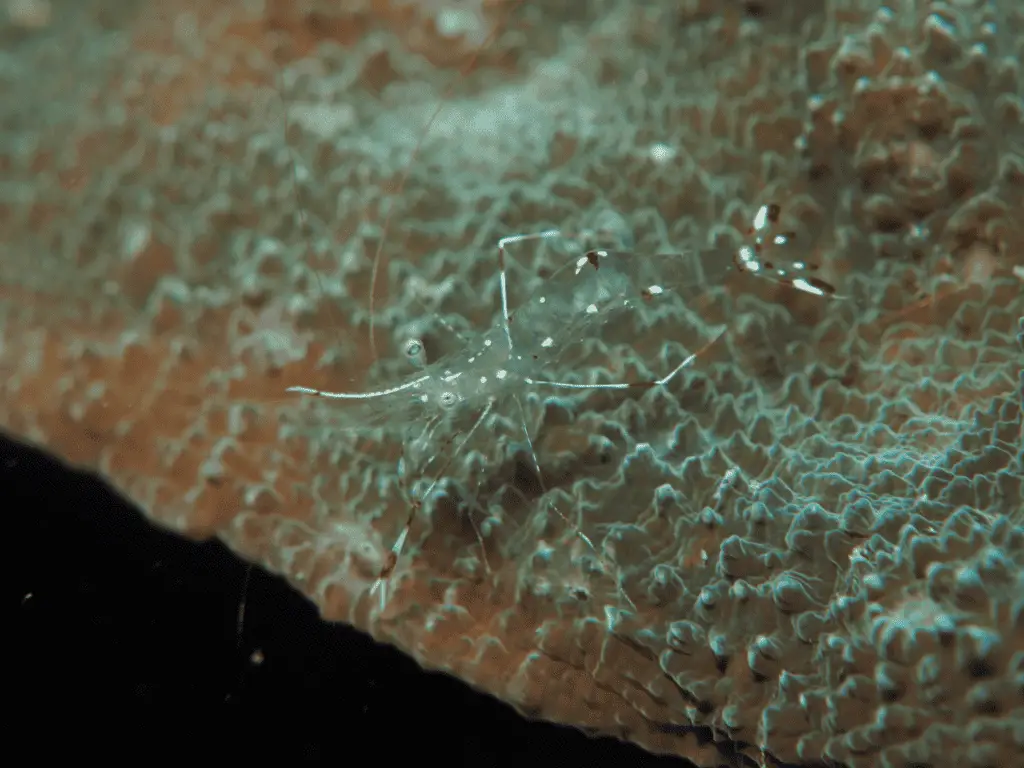
Breeding and Compatibility
We’ll explore how ghost shrimp reproduce and which tank mates are suitable to ensure a harmonious aquarium environment.
Reproduction Process
Ghost shrimp have a relatively straightforward breeding process in the home aquarium. We start with a mature male and female. The female carries the eggs under her tail until they hatch. The key to successful breeding lies in excellent water quality and a well-setup tank. To raise the fry, we must provide a safe environment where they are protected from predation. Larvae are particularly vulnerable during the first few days and require fine particulate food.
Tank Mate Compatibility
When choosing tank mates, we prioritize peaceful species that have proven to be good companions for ghost shrimp. Cory catfish, tetras, and snails are excellent choices due to their non-aggressive nature. However, we must be cautious with larger, more aggressive fish like cichlids and goldfish, as they may view ghost shrimp as food. Cherry shrimp and Amano shrimp can comfortably coexist with ghost shrimp, given their similar requirements and peaceful dispositions. It is critical for us to carefully consider the temperament and size of potential tank mates to maintain compatibility.
Frequently Asked Questions
In this section, we provide answers to some of the most common questions regarding the care and understanding of ghost shrimp in an aquarium setting.
How does one properly care for ghost shrimp in an aquarium?
To ensure the well-being of ghost shrimp, we maintain a clean tank with stable conditions. Regular water changes and a filtration system are crucial for their health. The aquarium should offer places to hide and a substrate suitable for burrowing.
What are suitable tank mates for ghost shrimp?
When choosing tank mates for ghost shrimp, we focus on peaceful community fish to avoid predation. Small fish, such as guppies and tetras, are typically compatible companions.
What is the ideal diet for ghost shrimp?
We feed ghost shrimp a varied diet that includes algae, plant debris, and prepared foods. Sinking pellets or flakes designed for shrimp and invertebrates supplement their nutritional needs.
What is the significance of ghost shrimp in their natural ecosystem?
In their natural habitat, ghost shrimp play a key role as detritivores. We observe them contributing to the breakdown of organic matter, aiding in nutrient cycling and promoting water quality.
Which water parameters are critical for the health of ghost shrimp?
We monitor water temperature, pH, and hardness closely—ideal conditions include a temperature range of 65-80°F, a pH of 7.0-8.0, and moderate water hardness. Ammonia and nitrate levels should be kept near zero.
What are some intriguing anatomical features of ghost shrimp?
Ghost shrimp are named for their transparent bodies, a feature that we find provides excellent camouflage against predators. Their fan-like appendages are highly specialized for filter feeding and maneuvering within the water column.
